<> Phalanta phalantha (Drury, [1773]) <>
the Common Leopard ผีเสื้อเสือดาวใหญ่
Click on any photo to see all photos full size in Lightbox
Additions and corrections to the information provided on this page is always welcome. Please use the Contact form.
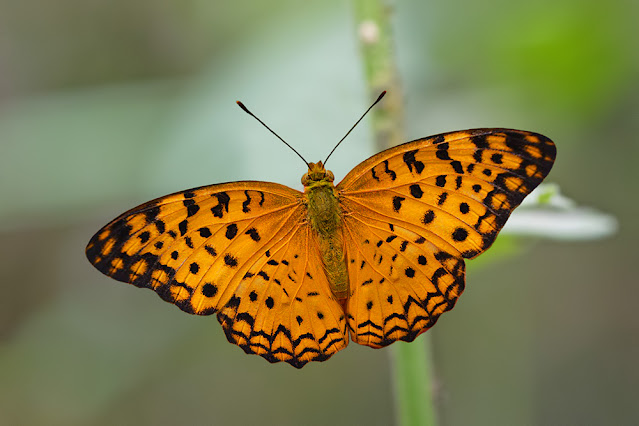
Photo taken at Doi Suthep-Pui National Park, Chiang Mai, Thailand. 460m a.s.l.

Phalanta phalantha is a sun-loving species that is common and widespread across the whole of S.E.Asia. It is a very active butterfly, rarely stopping for long, and is very easily disturbed. There is some slight variation in colour but the sexes are basically very similar in appearance. Males show strong territorial behaviour. It is usually found at low to moderate elevations but has been recorded up to 3500m in the Himalayas.
This species is multivoltine with several broods per annum. The adult female lays her eggs singly on the upperside or underside edges of young shoots on the host plant. Approximately 6-8 eggs are laid at a time but on different leaves. The larva eats the egg shell as its first meal after hatching.
Synonyms: Papilio phalantha, Papilio columbina, Atella phalanta, Argynnis phalantha
Taxonomy: Animalia - Arthropoda - Insecta - Lepidoptera - Nymphalidae - Heliconiinae - Phalanta - phalantha
Regional subspecies: Phalanta phalantha phalantha (most locations in the region), Phalanta phalantha columbina (S.China), Phalanta phalantha luzonica (Luzon-Philippines)
Regional Distribution: Nepal, Bhutan, India, Bangladesh, Myanmar, Thailand, Laos, Cambodia, Vietnam, China, Taiwan, Malaysia, Singapore, Indonesia, Philippines
 |
Lamnamkok National Park, Chiang Rai, Thailand 450m a.s.l. |
Habitat: Phalanta phalantha is found in evergreen & deciduous montane forest, and scrubland. Also frequently found in parks, gardens, and other urban areas. It has been recorded at elevations up to 3500m a.s.l. in the Himalayas.
Flight time: all year depending on location Wingspan: 50-60mm
Life History: egg 2 days instar 1 2 days instar 2 1-2 days instar 3 2 days instar 4 2 days instar 5 2-3 days pupa 10-15 days Total egg to adult 20-28 days
All times are approximate and can vary depending on the season and on the host used. The 5th instar does not always occur but the total time from egg to adult stays about the same.
Larval Hosts: Flacourtia indica, Flacourtia inermis, Flacourtia jangomas, Flacourtia montana, Flacourtia ramontchi, Flacourtia rukam, Populus ciliata, Salix babylonica, Salix kusanoi, Salix tetrasperma, Scolopia chinensis, Scolopia oldhamii, Xylosma congesta, Xylosma longifolia (Salicaceae), Barleria prionitis (Acanthaceae), Canthium coromandelicum, Coffea arabica (Rubiaceae), Mangifera indica (Anacardiaceae), Melaleuca leucadendra (Myrtaceae), Tridax procumbens (Asteraceae), Smilax aspera (Smilacaceae).
Actual host plant used depends upon location and availabilty of plant species.
Adult Food Sources: Nectar - Duranta erecta, Lantana camara, Stachytarpheta indica, Verbena rigida (Verbenaceae), Ageratina adenophora, Bidens pilosa, Chromolaena odorata, Cosmos caudatus, Cosmos bipinnatus, Crassocephalum cerpidioides, Cyanthillium conyzoides, Gaillardia pulchella, Gynura nitida, Lagasca mollis, Parthenium hysterophorus, Taraxacum javanicum, Tridax procumbens, Xanthium strumarium, Xerochrysum bracteatum, Youngia japonica (Asteraceae), Rhamnus wightii, Ziziphus mauritiana (Rhamnaceae), Alternanthera pungens, Celosia argentea (Amaranthaceae), Cnidoscolus aconitifolius, Euphorbia milii, Euphorbia rothiana (Euphorbiaceae), Cestrum aurantiacum, Solanum mauritianum (Solanaceae), Hypericum japonicum, Hypericum mysurense (Hypericaceae), Rostellularia procumbens (Acanthaceae), Sida acuta, Waltheria indica (Malvaceae), Oplismenus undulatifolius (Poaceae), Oxalis latifolia (Oxalidaceae), Coleus barbatus, Leucas lamiifolia, Platostoma axillaris, Premna serratifolia, Rotheca serrata, Tectona grandis, Vitex negundo (Lamiaceae), Cytisus scoparius (Fabaceae), Verbascum thapsus (Scrophulariaceae), Heynea trijuga (Meliaceae), Mappia nimmoniana (Icacinaceae), Rhodomyrtus tomentosa (Myrtaceae), Oenothera rosea (Onagraceae), Prinsepia utilis, Rubus ellipticus (Rosaceae), Antigonon leptopus (Polygonaceae), Carissa carandas (Apocynaceae), Santalum album (Santalaceae), Terminalia pallida (Combretaceae). Other: mud puddling.
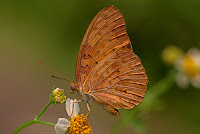 |
| Doi Suthep-Pui National Park, Chiang Mai, Thailand |
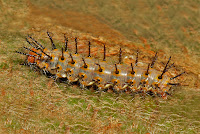 |
| late instar larva |
 |
| Chromolaena odorata, a nectar source |
%20gallery.jpg) |
| Doi Suthep-Pui National Park, Chiang Mai, Thailand |
 |
| pupa |
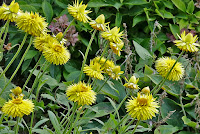 |
| Xerochrysum bracteatum, another nectar source |
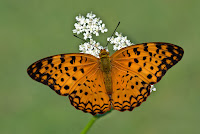 |
| Nahm Dong, Luang Prabang, Laos |
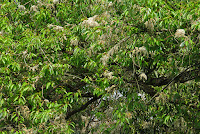 |
| Salix tetrasperma, a larval host |
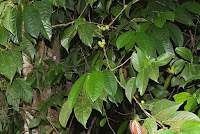 |
| Flacourtia rukam, another larval host |
Links to other pages in this series for species in the same subfamily
